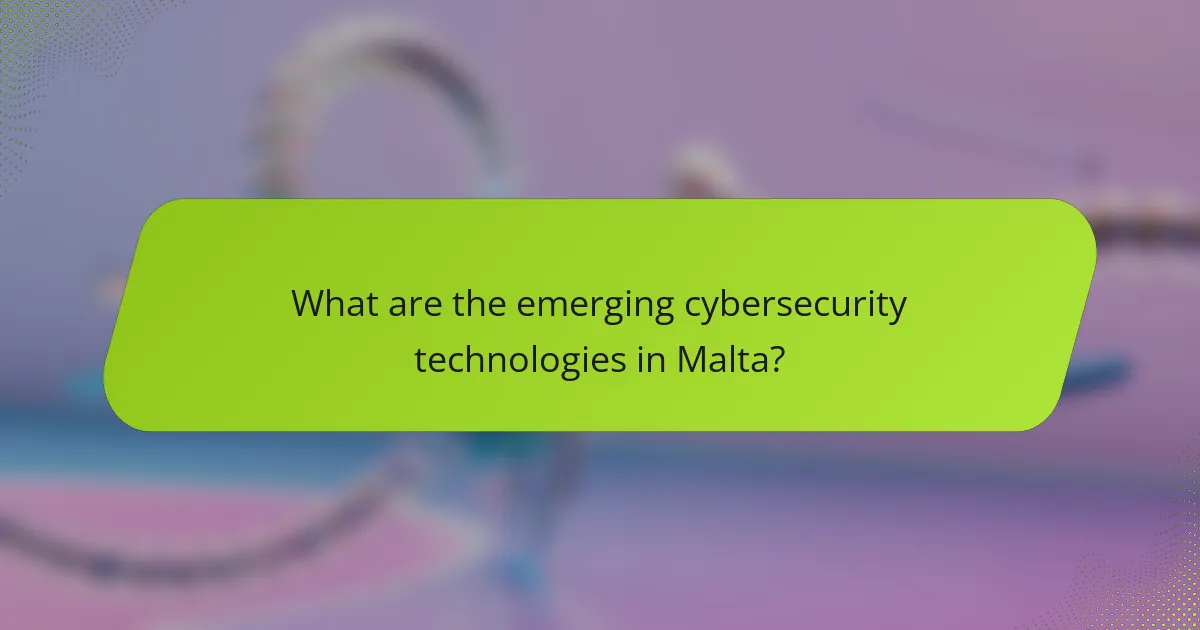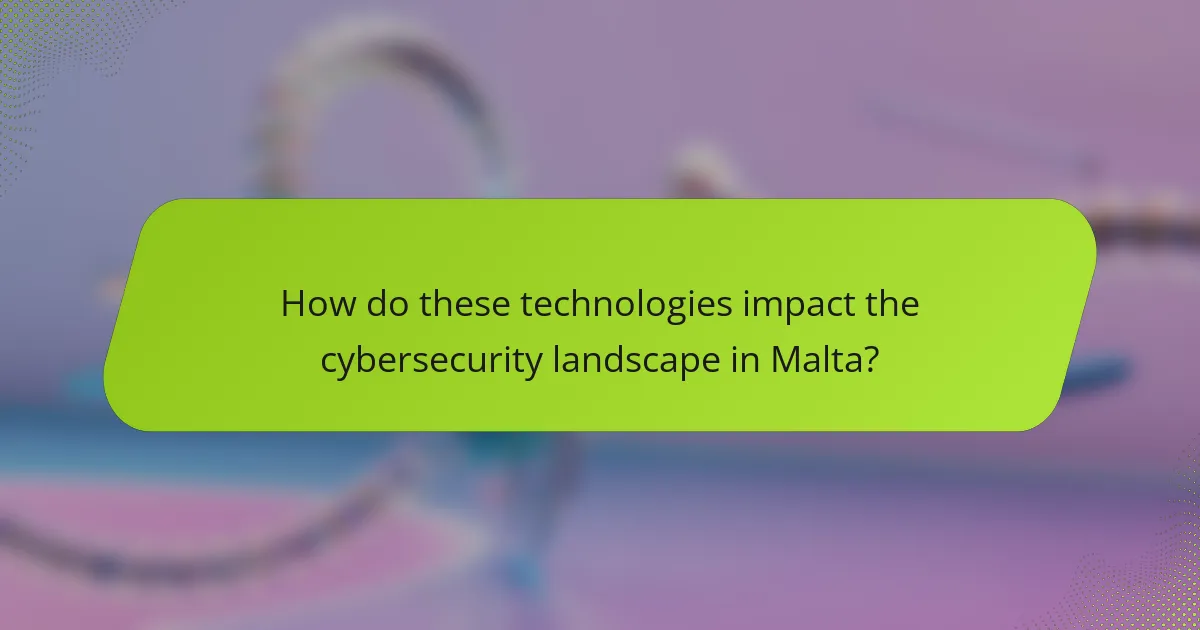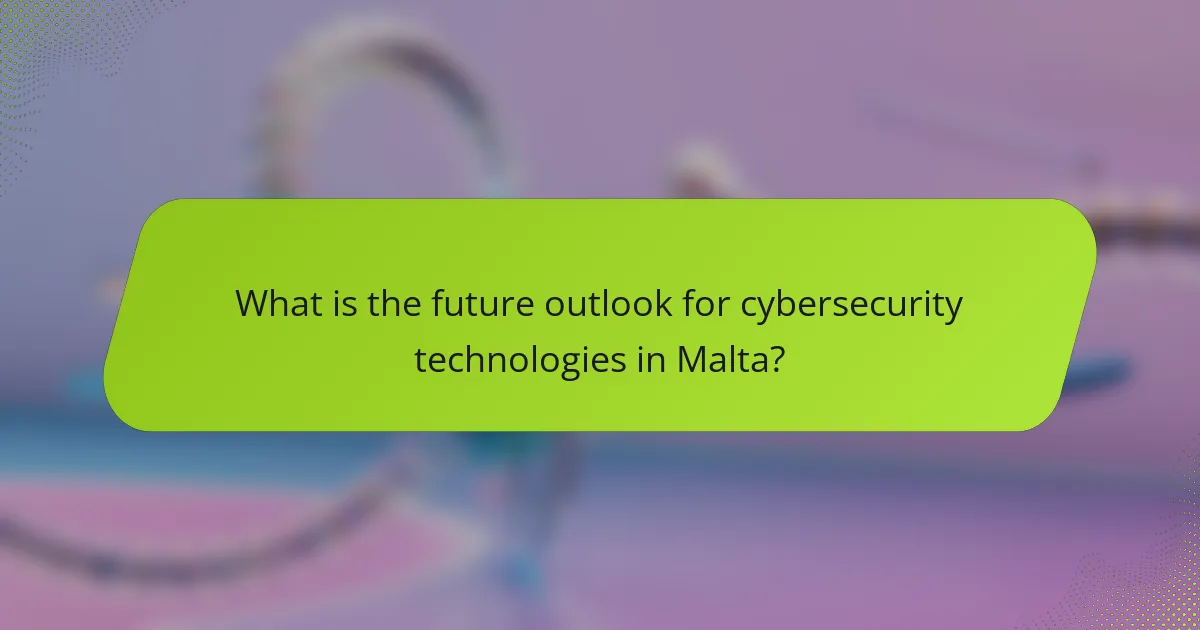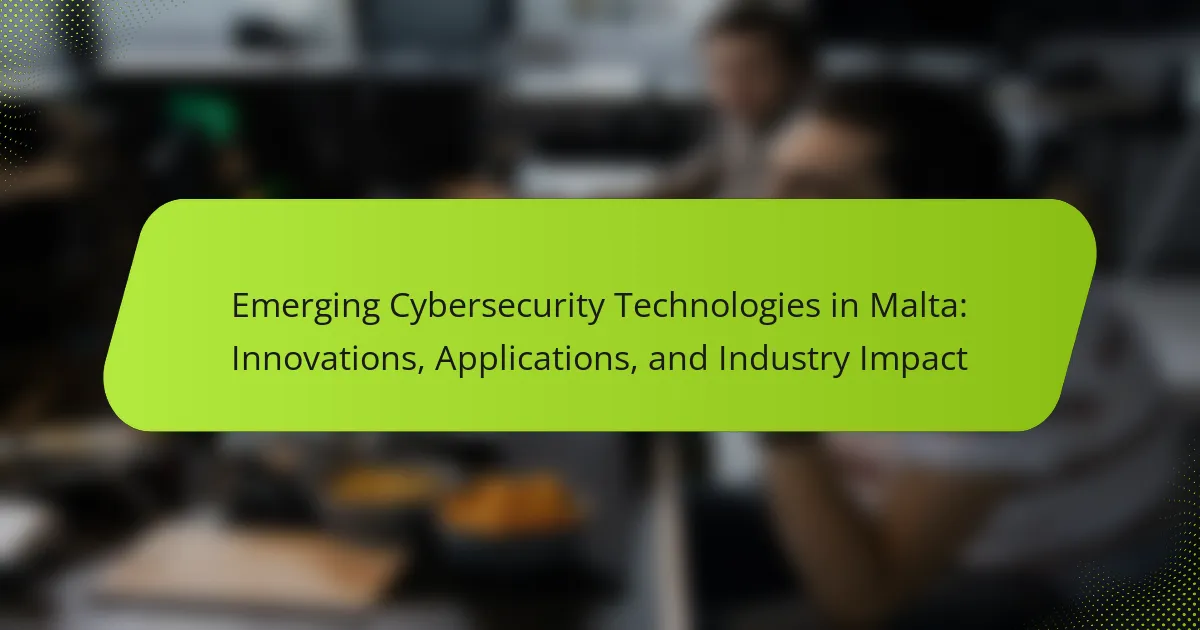
What are the emerging cybersecurity technologies in Malta?
Emerging cybersecurity technologies in Malta include artificial intelligence, machine learning, and blockchain. These technologies enhance threat detection and response capabilities. AI and machine learning algorithms analyze vast amounts of data to identify anomalies. Blockchain provides secure transaction methods, ensuring data integrity. Malta’s regulatory framework supports innovation in these areas. The government promotes initiatives to foster cybersecurity advancements. Industry collaborations drive the development of these technologies. Overall, Malta is positioning itself as a hub for cybersecurity innovation.
How are these technologies defined and categorized?
Emerging cybersecurity technologies are defined as innovative tools and systems designed to protect information and networks from cyber threats. These technologies are categorized based on their functionalities, such as threat detection, prevention, and response. Categories include intrusion detection systems, firewalls, encryption technologies, and endpoint protection solutions. Each category serves a specific purpose in safeguarding digital assets. For instance, intrusion detection systems monitor network traffic for suspicious activity. Firewalls control incoming and outgoing network traffic based on predetermined security rules. Encryption technologies secure data by converting it into a coded format. Endpoint protection solutions focus on securing individual devices connected to a network. This classification helps organizations select appropriate technologies based on their cybersecurity needs.
What are the key attributes of these technologies?
Key attributes of emerging cybersecurity technologies include advanced threat detection, real-time monitoring, and automated response capabilities. These technologies utilize machine learning algorithms to identify and mitigate threats swiftly. They also offer enhanced data encryption methods to protect sensitive information. Integration with cloud services is another significant attribute, allowing for scalable security solutions. User-centric designs improve accessibility and usability for various stakeholders. Compliance with regulatory standards ensures that these technologies meet legal requirements. Finally, continuous updates and improvements are essential to adapt to evolving cyber threats.
How do these technologies differ from traditional cybersecurity solutions?
Emerging cybersecurity technologies differ from traditional cybersecurity solutions primarily in their approach to threat detection and response. Traditional solutions often rely on signature-based detection, which identifies known threats through predefined signatures. In contrast, emerging technologies utilize advanced techniques like machine learning and behavioral analytics to detect anomalies and predict potential threats.
For example, machine learning algorithms can analyze vast amounts of data in real-time, identifying patterns that may indicate a breach. This proactive approach allows for quicker responses to new and evolving threats. Additionally, emerging technologies often incorporate automation, reducing the need for human intervention and minimizing response times.
Research shows that organizations using machine learning for cybersecurity experience a 60% reduction in false positives compared to traditional methods. This demonstrates the effectiveness of these innovative technologies in enhancing security measures.
What innovations are driving cybersecurity advancements in Malta?
Artificial intelligence and machine learning are driving cybersecurity advancements in Malta. These technologies enhance threat detection and response capabilities. AI algorithms analyze vast amounts of data for anomalies. Machine learning models adapt to new threats in real time. Blockchain technology is also being utilized for secure data sharing. It ensures data integrity and transparency in transactions. Additionally, Malta is investing in cybersecurity education and training programs. This initiative aims to build a skilled workforce to tackle emerging threats. The collaboration between government and private sectors fosters innovation in cybersecurity solutions.
How is artificial intelligence being utilized in cybersecurity?
Artificial intelligence is utilized in cybersecurity to enhance threat detection and response. AI algorithms analyze vast amounts of data to identify patterns indicative of cyber threats. Machine learning models continuously improve by learning from new data. This enables faster identification of anomalies and potential breaches. AI also automates routine security tasks, reducing the workload on human analysts. For instance, according to a report by McKinsey, AI can improve threat detection rates by up to 95%. Moreover, AI systems can predict and mitigate risks before they escalate. This proactive approach significantly strengthens overall cybersecurity measures.
What role does blockchain play in enhancing cybersecurity measures?
Blockchain enhances cybersecurity measures by providing a decentralized and tamper-resistant ledger. This technology ensures data integrity through cryptographic hashing. Each transaction on a blockchain is securely encrypted and linked to previous transactions. This linkage makes it extremely difficult for unauthorized users to alter data. Additionally, blockchain supports transparency and traceability in data management. These features help in identifying and mitigating security breaches quickly. According to a report by IBM, blockchain can reduce the cost of data breaches by up to 30%. This demonstrates its effectiveness in strengthening cybersecurity frameworks.
What applications do these technologies have in various sectors?
Emerging cybersecurity technologies have applications across various sectors. In finance, they protect sensitive data and prevent fraud. In healthcare, they secure patient information and ensure compliance with regulations. The retail sector utilizes these technologies to safeguard customer transactions and personal details. Government agencies employ cybersecurity measures to protect national security and critical infrastructure. Education institutions use them to secure student data and online learning platforms. Additionally, manufacturing relies on cybersecurity to protect intellectual property and operational systems. Each sector benefits from enhanced security measures to mitigate risks and ensure data integrity.
How are emerging technologies applied in financial services?
Emerging technologies are applied in financial services through automation, data analytics, and enhanced security measures. Automation streamlines processes like transaction processing and customer service through chatbots. Data analytics enables financial institutions to analyze customer behavior and improve decision-making. Enhanced security measures, such as blockchain and biometric authentication, protect against fraud and cyber threats. For instance, blockchain technology ensures secure and transparent transactions. According to a report by McKinsey, 80% of banks are investing in AI to enhance customer experience and operational efficiency. These applications demonstrate how emerging technologies are transforming the financial services landscape.
What impact do these technologies have on healthcare cybersecurity?
Emerging cybersecurity technologies significantly enhance healthcare cybersecurity. These technologies improve threat detection and response capabilities. They utilize advanced algorithms and machine learning to identify vulnerabilities. Healthcare organizations can better protect sensitive patient data through encryption techniques. Additionally, technologies like blockchain ensure data integrity and secure sharing. The implementation of multi-factor authentication reduces unauthorized access risks. According to a 2021 report by Cybersecurity Ventures, healthcare breaches increased by 55% in 2020, highlighting the urgent need for these technologies. Overall, these innovations play a critical role in safeguarding healthcare systems against cyber threats.

How do these technologies impact the cybersecurity landscape in Malta?
Emerging cybersecurity technologies significantly enhance the cybersecurity landscape in Malta. These technologies improve threat detection and response capabilities. For example, the use of artificial intelligence allows for real-time analysis of network traffic. This enables quicker identification of potential threats. Additionally, advanced encryption methods protect sensitive data from unauthorized access. The implementation of blockchain technology enhances data integrity and transparency. Furthermore, cloud security solutions offer scalable protection for businesses. According to the National Cyber Security Strategy, Malta aims to bolster its cybersecurity framework through these innovations. This strategic approach positions Malta as a leader in cybersecurity within the region.
What are the benefits of adopting emerging cybersecurity technologies?
Adopting emerging cybersecurity technologies enhances protection against cyber threats. These technologies provide advanced threat detection capabilities. They use artificial intelligence to identify anomalies in real-time. This leads to quicker incident response times. Improved data encryption methods ensure sensitive information remains secure. Additionally, automation reduces human error in cybersecurity processes. Emerging technologies also facilitate compliance with regulations. This is crucial for organizations in Malta and beyond. Overall, these benefits contribute to a stronger cybersecurity posture.
How do these technologies improve threat detection and response?
Emerging cybersecurity technologies improve threat detection and response by utilizing advanced algorithms and machine learning. These technologies analyze vast amounts of data in real-time. They identify patterns and anomalies that indicate potential threats. For instance, machine learning models can detect unusual network behavior, allowing for quicker response times. Automated systems can respond to threats without human intervention, reducing reaction delays. Additionally, threat intelligence platforms provide contextual information about emerging threats. This information helps organizations prioritize their response efforts effectively. According to a report by Cybersecurity Ventures, AI-driven security solutions can reduce incident response times by up to 90%.
What cost savings can be achieved through their implementation?
Cost savings achieved through the implementation of emerging cybersecurity technologies in Malta can be significant. These technologies reduce the risk of data breaches, which can cost companies up to $3.86 million on average per incident, according to IBM’s Cost of a Data Breach Report 2020. By proactively addressing vulnerabilities, organizations can avoid these hefty fines and losses. Automation in cybersecurity processes can also lower labor costs by up to 30%, as reported by a study from McKinsey & Company. Additionally, the use of cloud-based security solutions can decrease infrastructure costs by eliminating the need for on-premises hardware. Overall, these technologies not only enhance security but also lead to substantial financial benefits for organizations in Malta.
What challenges do organizations face when implementing these technologies?
Organizations face several challenges when implementing emerging cybersecurity technologies. These challenges include high costs associated with acquiring and maintaining new technologies. Limited technical expertise within the organization can hinder effective implementation. Integration with existing systems often proves difficult and time-consuming. Additionally, organizations may encounter resistance to change from employees. Compliance with regulatory requirements can complicate the adoption process. Rapidly evolving threats require constant updates to technologies, creating ongoing resource demands. Lastly, measuring the effectiveness of new technologies can be challenging, making it hard to justify investments.
How can organizations overcome resistance to new technology adoption?
Organizations can overcome resistance to new technology adoption by fostering a culture of openness and communication. Engaging employees early in the process reduces anxiety and builds trust. Providing training and support enhances user confidence in new systems. Demonstrating the benefits of the technology through case studies can motivate employees to embrace change. Leadership should actively endorse the technology, showcasing its importance to organizational goals. Addressing concerns and feedback promptly can help alleviate fears associated with the transition. Research indicates that organizations with strong change management strategies see higher adoption rates, with studies showing a 70% success rate in technology implementation when employees are involved.
What are the common pitfalls in deploying these cybersecurity innovations?
Common pitfalls in deploying cybersecurity innovations include insufficient training for personnel. Organizations often overlook the need for comprehensive education on new technologies. This can lead to misuse or ineffective application of tools. Another pitfall is the lack of integration with existing systems. New innovations may not work seamlessly with legacy systems, causing operational disruptions. Additionally, organizations may underestimate the importance of ongoing maintenance and updates. Cyber threats evolve, and technologies must be regularly updated to remain effective. Budget constraints can also hinder the proper implementation of innovations. Limited funding may prevent the acquisition of necessary resources. Lastly, over-reliance on technology without adequate human oversight can create vulnerabilities. A balanced approach that combines technology with human expertise is essential for effective cybersecurity.

What is the future outlook for cybersecurity technologies in Malta?
The future outlook for cybersecurity technologies in Malta is promising and dynamic. The Maltese government is investing heavily in cybersecurity initiatives. This includes the establishment of the Malta Cyber Security Agency. The agency aims to enhance national cybersecurity resilience. Additionally, Malta’s strategic location makes it an attractive hub for tech companies. The growing demand for cybersecurity solutions is evident in various sectors. Reports indicate an increased focus on artificial intelligence in cybersecurity. This trend is expected to improve threat detection and response times. Furthermore, Malta’s regulatory framework supports innovation in cybersecurity technologies. Overall, advancements in cybersecurity will play a crucial role in Malta’s digital economy.
How are regulatory changes influencing cybersecurity technology trends?
Regulatory changes are significantly influencing cybersecurity technology trends by mandating stricter compliance measures. These regulations often require organizations to adopt advanced security protocols. For example, the General Data Protection Regulation (GDPR) enforces data protection and privacy standards. Compliance with GDPR has led to increased investment in encryption technologies. Additionally, regulations like the Cybersecurity Framework from NIST encourage the adoption of risk management practices. Companies are now integrating automated compliance tools to streamline adherence to these regulations. This shift is driving innovation in cybersecurity solutions, particularly in threat detection and response capabilities. Overall, regulatory changes are shaping the landscape of cybersecurity technology by promoting enhanced security measures.
What role do government initiatives play in fostering innovation?
Government initiatives play a crucial role in fostering innovation by providing funding, resources, and regulatory support. These initiatives often include grants and subsidies for research and development. They create innovation hubs and incubators to support startups. Government policies can also streamline regulations that promote technological advancements. For example, Malta has implemented the Digital Innovation Hub to enhance cybersecurity technologies. This hub connects businesses with research institutions. It facilitates collaboration to drive innovation in emerging technologies. Such initiatives have been shown to increase investment in the tech sector. The result is a more vibrant ecosystem for innovation and economic growth.
What best practices should organizations follow when integrating these technologies?
Organizations should prioritize thorough planning when integrating emerging cybersecurity technologies. This involves assessing current infrastructure and identifying gaps. Regular training for employees is essential to ensure they understand new technologies. Establishing clear policies and protocols enhances compliance and security. Continuous monitoring of the integrated technologies is crucial for identifying vulnerabilities. Collaborating with cybersecurity experts can provide valuable insights and recommendations. Implementing a phased approach allows for gradual adaptation and reduces risks. Finally, organizations should stay updated on industry trends to adapt their strategies accordingly.
How can organizations ensure ongoing training and awareness among employees?
Organizations can ensure ongoing training and awareness among employees by implementing regular training programs. These programs should cover the latest cybersecurity threats and best practices. Scheduled workshops and seminars can reinforce knowledge and skills. Online training modules offer flexibility for employees to learn at their own pace. Additionally, real-time simulations can enhance practical understanding of cybersecurity scenarios. Regular updates on emerging threats keep employees informed. Incentivizing participation in training can boost engagement. Research shows that organizations with continuous training reduce cybersecurity incidents by 50%.
What strategies can be employed to stay ahead of emerging threats?
Implementing proactive threat intelligence is crucial to staying ahead of emerging threats. Organizations should regularly analyze threat data to identify potential vulnerabilities. This involves collaborating with cybersecurity experts and sharing information across industries. Regular training and awareness programs for employees can mitigate risks from human error. Additionally, adopting advanced security technologies, such as AI-driven analytics, enhances threat detection capabilities. Continuous monitoring of network activities helps in early threat identification. Conducting regular security audits ensures compliance and identifies weaknesses. Finally, developing an incident response plan prepares organizations for quick action against potential breaches.
Emerging cybersecurity technologies in Malta, including artificial intelligence, machine learning, and blockchain, are transforming the landscape of digital security. These innovations enhance threat detection, response capabilities, and data integrity across various sectors, such as finance and healthcare. The article explores the definitions and categorizations of these technologies, their key attributes, and how they differ from traditional solutions. Additionally, it examines the challenges organizations face in implementation and the role of government initiatives in fostering innovation. Overall, the advancements in cybersecurity technologies position Malta as a leader in the field, contributing significantly to the nation’s digital economy.
